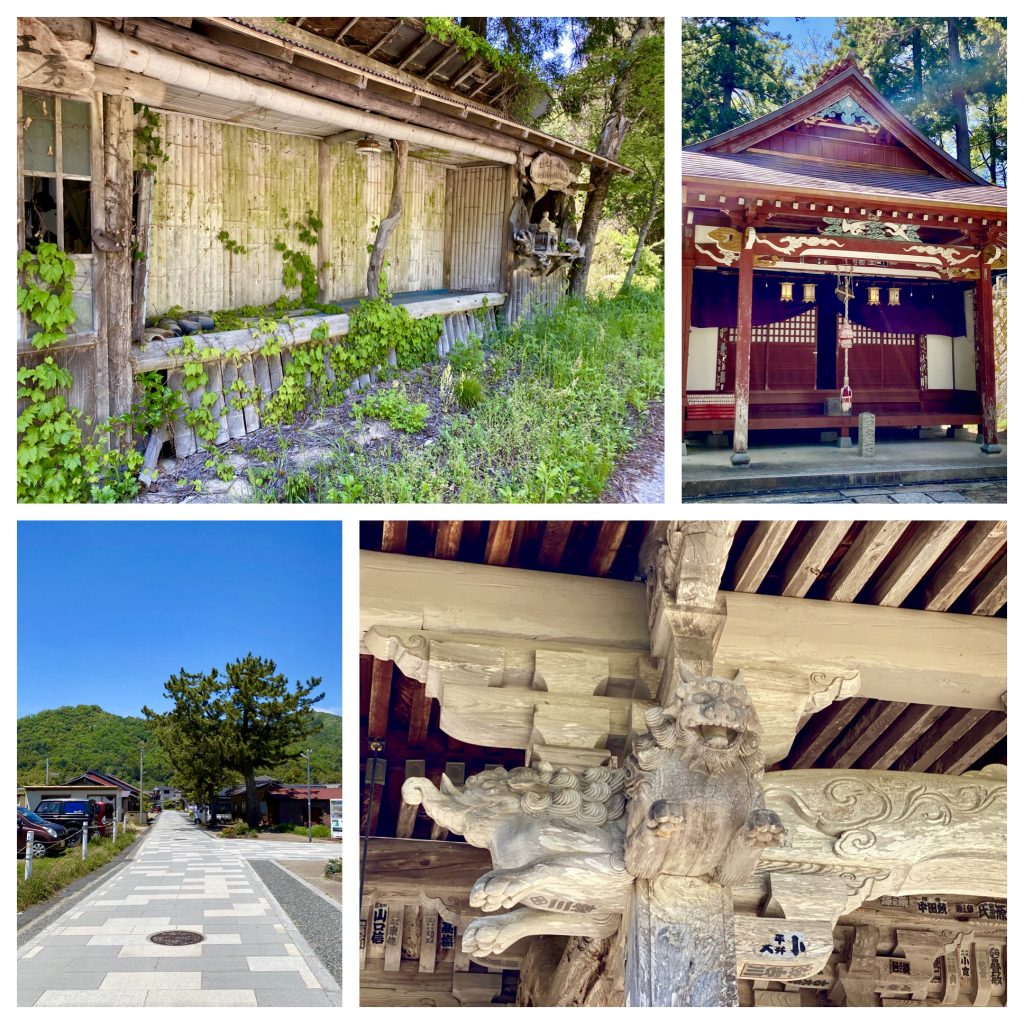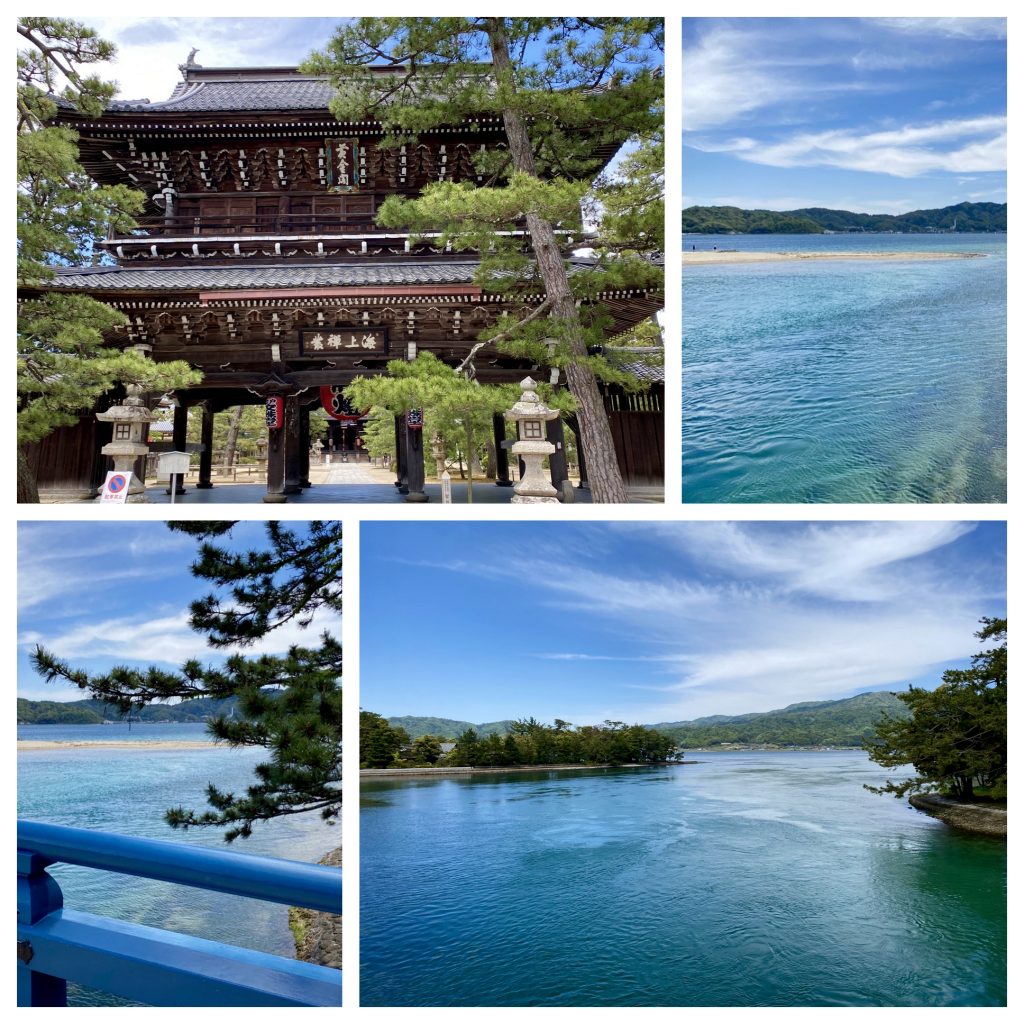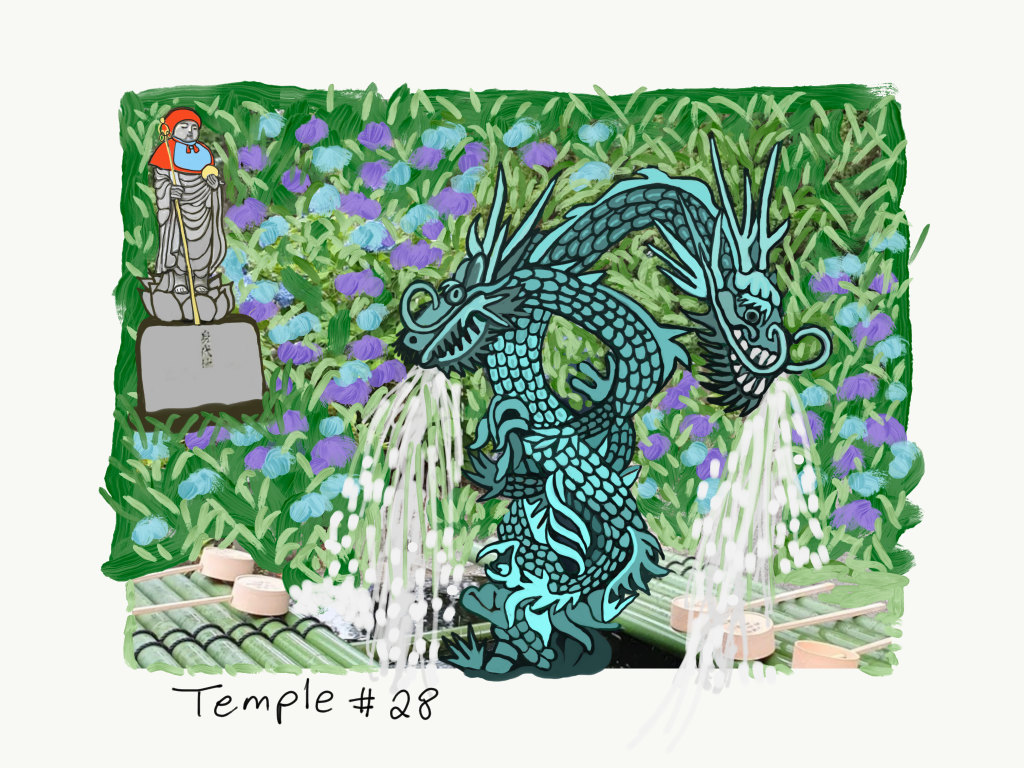Day 52 - The Road To Enlightenment - Walking The Saigoku Kannon Pilgrimage - Nariaiji, Temple #28 and the Scenic Amanohashidate, Japan
Day 52 - The Road To Enlightenment - Walking The Saigoku Kannon Pilgrimage - Nariaiji, Temple #28 and the Scenic Amanohashidate, Japan
Today was a very long and tiring day.
We planned to take the train to the Amanohashidate Station, and walk across the scenic sand bar to the other side of the harbor, and then to climb up the very steep mountain to the temple grounds.
Normally visitors to this mountaintop temple ride the cablecars of the ropeway up the mountain and then take a small bus further up, to the entrance to the temple.
But the ropeway was closed and there were no buses.
To get to Amanohashidate station from our hotel took a bit over two hours on a succession of local trains.
To add to this, the temple is now open for much shorter hours, and the gates are closed daily at three o’clock in the afternoon.
It would have been easier to visit the temple tomorrow, when we relocate to our next accommodation in Miyazu, but our hotel in Uminpia has agreed to hold our duffel bag until we finish walking our pilgrimage.
Then they will ship it to Nikko for us, where we have booked a few nights in a ski resort in the mountains, with the intentions of resting after the pilgrimage and doing some hiking in the mountains.
Because this temple will be the last temple we are able to visit on the pilgrimage (the three others are closed), we can put our pilgrimage scroll and book in the duffel bag, and not carry them with us on our walk towards Himeji.
We have been getting so many hotel cancellations of places that were closing down, that it is much better to be super light footed and flexible at these times, and not to be carrying a heavy bag with us.
All this means that today’s long walk up and down the mountain will have to be a bit rushed, in order for us to complete it all and return to our hotel by seven thirty in the evening, in time for dinner.
We disembarked from the train at the scenic Amanohashidate seaside town.
Amanohashidate is known as “Kyoto By The Sea.”
It is one of the three most scenic spots in Japan, along with Matsushima in Miyagi Prefecture, and Miyajima in Hiroshima Prefecture.
We have already visited the other two, and now we are seeing the third.
The streets of the seaside town were empty and almost all of the shops were closed.
A handful of places were doing takeaway meals, with signs that said “Sorry, for locals only.”
It was an eerie feeling.
But we really did not have time to dine or take a coffee break, even if places were open.
We said a quick prayer at at Chionji temple, located right at the entrance to the bridge that takes you to the sandbar across the sea.
This bridge used to be a hand operated turning bridge, that allowed people to cross and for boats to enter the sea.
It is still operating as a turning bridge to allow barges through, but it is motorized nowadays.
The sand bar is a unique natural bridge, that stretches for 2.6 kilometers after the bridge and crosses the sea to the other side.
It is planted with old pine trees to block the winds, and it has white sandy beaches.
There is a shinto shrine in the middle, and lots of benches and tables and public toilets throughout the dragon’s back sand bar.
It is referred to as the dragon’s back, because it looks like a dragon has crouched down in the sea, and only his long back is visible to walk on.
We took a tea break during the walk across the dragon’s back, and quickly packed our things and walked to the other side.
We saw the cable cars at the ropeway, all stationary, with the gates closed.
My map showed that there was a way to walk on the left side of the ropeway, up a steep mountain to the temple, which was shorter than the car road up to the temple.
Jules was encouraging me to make up my mind, because of our tight schedule.
At the traffic light, I saw a local woman and asked her if it was possible to walk up to the temple from there.
She said that it was not possible, so we continued walking on the car road.
As it turned out, she was wrong.
So much for asking the locals, who are supposed to know everything about the area that they live in.
Like Jules said, she has never walked up to the temple and therefore had no knowledge of the steep stairs that go up there.
We continued along the car road, which was scenic but long.
We did not stop to take photos so as not to slow us down.
We just walked as quickly as we could.
Rushing and long distance walking do not go easily hand in hand.
We passed by an old lady who was holding a few wildflowers in one hand and her walker in the other hand.
She sat by the road near a small cemetery.
I thought perhaps she had lost her husband or child, and every day she was doing her daily walk, to place flowers on the grave and to be outdoors and exercise a bit.
I wished her a good day and her face lit up with a huge smile.
When we turned up the road to the mountain, the road became very twisty and very steep.
All the elevation gain was at that stage, and we climbed 1476 feet above sea level in about five kilometers.
We had to stop to catch our breaths and we did it by allowing ourselves to stand for only about a minute in the shade, and then we continued climbing.
We passed by a statue of Kobo Daishi, the famous Buddhist Miracle worker who established the 88 temples along the Shikoku pilgrimage, and the Shingon sect of Buddhism in Japan.
I stopped to pay my respects and to say a prayer.
“Dear Kobo Daishi, the world really needs a miracle right now....
And please help us, we are struggling right now...”
Even as I said it, I felt like an idiot.
We are not struggling.
We are healthy and strong, free and roaming the mountains in search of Enlightenment.
So what if it is a hot day and a hard climb up a steep mountain?
We know that the journey is not in vain, that the temple is open and that soon we would be enjoying the shade of the ancient temple.
We arrived at the top and the friendly man at the front gate looked at us with awe and amazement.
The he apologized for charging the entry fee and told us that if we had come yesterday, the temple would have been closed.
But today it is open and we are welcome to visit.
He gave us a map and described the different walking routes we could take around the temple grounds.
First we went up to the main hall and got our scroll and book stamped, and then we chanted the Heart Sutra and prayed for the enlightenment of all sentient beings.
Nariaiji Temple is a Shingon sect temple which that was originally located near the top of Mount Tsuzumigatake, which is called today Mt. Nariai.
It was moved to its current location further down the mountain, after a major landslide that happened about 250 years ago.
The current temple grounds are still very high on the slopes, and offer really nice views over the bay below.
Nariaiji Temple’s main object of worship is a carved wooden statue of Kannon, the Buddhist Goddess of Mercy, that dates from the Heian Period, (around the 700’s).
Below the main hall there is a small wooden bell tower, containing a bronze bell.
The bell is completely enclosed in its tower, and it has never been struck.
This is because of a sad legend about its origins.
It is said that a baby was accidentally dropped into the molten metal, as it was being cast into the bell.
A little further down the slope stands an impressive five story pagoda (rebuilt in the 1990s) which stands next to a big pond.
Along the stairs to the main hall, sits a “One Wish Jiso” statue, said to grant pilgrims their innermost heart wishes.
Nariaiji Temple is known as the place where wishes come true.
The Kannon Goddess is depicted in the form of a beautiful woman, and it is said those who come to the temple are granted a beautiful body and spirit.
Nariaiji Temple’s gardens are regarded as some of the most beautiful in the area.
In the Spring, it is the cherry blossoms and the rhododendrons that bloom, and in the Autumn, the Japanese maples set the grounds alight in a blaze of red colors.
The temple has another legend associated with it.
It is known as the Kannon Goddess of Sacrifice.
Long ago a monk lived in solitude in a thatched hut on the mountain.
He secluded himself in the pursuit of the ultimate knowledge.
This hut, on the side of Mt. Nariai, was exposed to the freezing winter, stormy weather and severe winds and rains.
Normally, kind people who lived in the valley below would climb up once or twice per year, bringing him gifts of rice from the harvest and salt from the sea.
But one especially harsh winter, the people in the nearby village lost their houses and ran out of provisions, and were on the brink of starvation.
The monk, feeling powerless to stop his own impending death, prayed to the deity to bless each and every meal of the day.
In his state of starvation, he was delirious.
Uncertain as to what was a dream state and what was reality, he saw a deer which had been wounded by a wolf fall in the snow outside his hut.
He fought with himself about about whether he should break his vows of never eating meat, and eat the meat of the dead deer to save himself.
In the end, he determined that he wasn’t taking a life, so he cut off the thigh of the deer, boiled it in his cooking pot and ate it.
Before long, the snows receded and the villagers trekked up to the monk’s hut.
They entered the main hall and noticed that a chunk of wood had been taken out of the thigh of the wooden statue of the Kannon Goddess deity which stood inside the hall.
In the monk’s cooking pot, they saw the wood shavings that remained.
The monk believed that Kannon had changed her shape and sacrificed her thigh in order to save him.
So he emptied out his pot and the remaining wood shavings and packed them into the cavity that was left in the statue’s thigh and it returned back to normal.
It was late by the time we finished and started walking down the mountain.
We knew that we had to cover another ten kilometers, in order to get to the Amanohashidate train station in time for our two hour train ride back.
There was no way we could walk back down down the car road in time.
So we decided to take the road leading to the closed ropeway, knowing full well that it could end with a closed gate.
I told Jules that we might have to climb the gate, or go into the forest and bypass it.
I wanted him to be prepared for a closed road if it comes.
Google maps showed a dead end, but my “Pocket Earth” mapping app, showed a hiking only trail down to the road.
In his fatigue, Jules said to me:
“You always choose the risky way to go, instead of the safe route.”
I explained that there was NO CHANCE that we could make the train in time by taking the route we had had climbed on.
We were both feeling fatigued from the rushed walk up the mountain, and now we had a very steep road ahead of us.
But the bay below us was so beautiful, that we soon forgot about the difficulties.
The road split into the hiking only trail that I saw on my map.
We could continue down it and maybe face a gated road, or we could climb down these sets of hundreds of stairs, with the hope that they would take us down to the road.
We chose the stairs.
We carefully climbed down many hundreds of stairs, and got to an observation deck that had two young women taking selfiess.
I was SO relieved to see them.
I knew that they had not come down from the temple in their dresses, which only meant that there was a way down.
And indeed, in about half a kilometer, I saw the road ahead and the sand bar we had to cross back.
This time our crossing of the dragon‘s back was a bit more relaxed.
We saw people exercising and young couples hugging in privacy, falling in sweet love during the coronavirus times...
It was so charming.
We arrived at the train station with plenty of time to drink more of our tea and have a snack.
Two hours later, we were back at our hotel.
We took quick showers and went to enjoy our last wonderful dinner in the hotel restaurant.
The chef made us a great menu of seared scallops with local oranges and seafood bouillabaisse with a risotto, just to name a few of the great dishes.
We were in bed and asleep before our heads rested on the pillow.
With love and warm dreams,
Tali and Jules
Daily stats:
Steps walked - 28,639
21 km. walked
Active walking time - 5 hours
Total walking time today - 9 hours.
Total walking distance on the Saigoku to date - 912.5 km
Temple Visited:
#28, Nariaiji Temple (成相寺) in Amanohashidate, Temple #28















